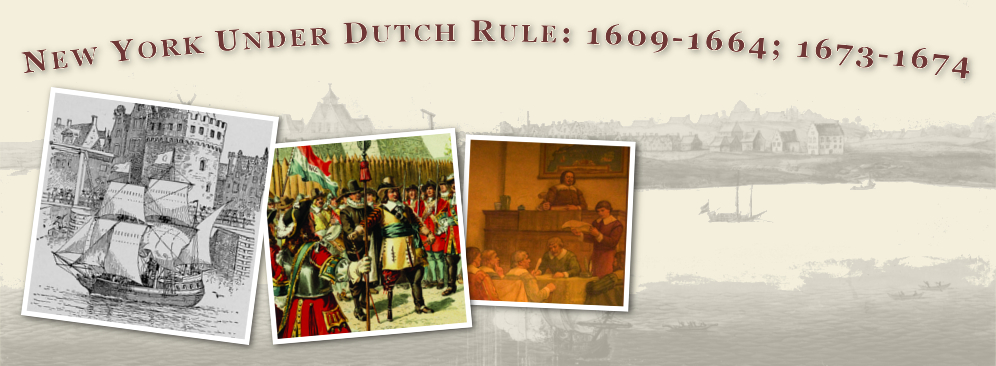In the 16th century, the great powers of Europe asserted the right to establish colonies on the other continents of the world based on international law claims of “first discovery and occupation.” On September 11, 1609, the Dutch ship, the Halve Maen, entered New York Bay and sailed up the mighty river it found there. The river is known as the Hudson in honor of the ship’s captain, Henry Hudson. The colony was named New Netherland.
Boundaries of New Netherland
New Netherland was much larger than the State of New York and extended from the Delmarva Peninsula to southwestern Cape Cod, and included lands that now form parts of the States of New Jersey, Delaware, and Connecticut. New Netherland also claimed small outposts in Pennsylvania and Rhode Island.
New Netherland Company Monopoly
By 1611, Dutch merchants had started to sail across the Atlantic Ocean to New Netherland to trade cloth and other commodities for beaver and otter pelts. In 1614, a group of Dutch merchants formed The New Netherland Company and obtained a three-year fur trading monopoly from the Dutch government, the States General of the United Provinces. Although that company established an outpost known as Fort Orange on Castle Island near Albany in 1615, these merchants were not settlers.
Dutch West India Company
In 1621, another merchant group incorporated the Dutch West India Company (the Company) and obtained from the States General a charter that granted it a twenty-four-year trading monopoly in all the lands claimed by the Dutch in the Americas and Africa. The charter, dated June 3, 1621, gave the Company almost complete administrative and judicial power, including the power to “appoint and remove governors, officers of justice and other public officers, for the preservation of the places, keeping good order, police and justice in like manner for the promoting of trade.” By 1623, the Company had drawn up plans to settle New Netherland and the first ships, laden with colonists and supplies, arrived in the colony in 1625.
New Netherland Becomes New York
Against the backdrop of the 17th century Anglo-Dutch wars, Charles II of England ordered the invasion of New Netherland in 1664. The English claim to the colony was based upon the voyages of exploration commissioned by Henry VII that had discovered the Atlantic coast of North America in 1497 and 1498. Richard Nicoll was commissioned to lead the attack and when the English fleet sailed into New York harbor, the Dutch recognized the superiority of the invading fleet and surrendered to the English on September 8, 1664. This change of sovereignty was confirmed in the Treaty of Breda, 1667.
Dutch Form of Government Restored
The Third Anglo-Dutch war broke out in 1672 and, in 1673, a Dutch fleet arrived in the New York harbor. The Governor of New, York, Francis Lovelace, was engaged in negotiations with Governor of Connecticut and was absent from the colony. When the Dutch issued a demand for surrender, the Governor’s deputy, Captain John Manning, without authorization, immediately complied. The colony was renamed New Netherland and the Dutch form of government was restored. Within a year, the Third Anglo-Dutch war ended with the 1674 Treaty of Westminister that returned New Netherland to English rule.


Important Figures
Directors & Director-General, 1623-1664
Unknown Director of New Netherland, 1624 Adriaen Jorisz Thienpont was appointed the first Director of New Netherland on June 20, ...
Unknown Provisional Director of New Netherland, 1625-1626 In 1625, the Amsterdam Chamber of the Dutch West India Company sent an ...
c. 1580-Unknown Provisional Director of New Netherland, 1625 Captain Cornelis Jacobson Mey was an experienced captain in the Dutch merchant ...
1580-1638 Director of New Netherland, 1626-1633 Pieter Minuit, born in 1580, was a Walloon from Wesel, Duchy of Cleves. By ...
1595-c. 1645 Director of New Netherland, 1632-1633 Bastiaen Jansz Krol, a silk worker by trade, was born in Harlingen, Friesland ...
1606-1657 Director of New Netherland, 1633-1637 Wouter Van Twiller was born in Nieukirk, Holland on May 22, 1606, and became ...
1597-1647 Director of New Netherland, 1638-1646 Willem Kieft was born in September 1597 in Amsterdam, Holland. Educated to become a ...
c. 1612-1672 Director-General of New Netherland, 1647-1664 Pieter Stuyvesant was born in Friesland in the Netherlands around 1612. He studied ...
Governors, 1673-1674
Fiscael, 1625-1664, 1673-1674
1610-1688 Schout-Fiscael of New Netherland, 1645-1651 Hendrick Thomasse Van Dijck was born in Holland in 1610, and came to New ...
Unknown Council of New Netherland, 1647-1653 Schout-Fiscael of New Netherland (Substituting), 1652 Brian Newton was an Englishman who entered the ...
Unknown Fiscael of New Netherland, 1673-1674 In 1673, Willem Knijff was the Captain of the company of Netherlands Infantry stationed ...
Schout, New Amsterdam, 1653-1665, 1673-1674
About the Period
Courts of the Era
Remonstrances, Protests & Boards of Representatives
Charters, Codes & Treaties
The Treaty of Breda, concluded on July 31, 1667, between England, the Dutch Republic, France, and Denmark, brought an end ...
The ship Swanenburgh, anchored betwixt Staten and Long Island. 9th of August, 1673 Sir :—The force of war now lying ...
This peace treaty ended the Third Anglo-Dutch War. It was concluded between the Netherlands and England, and provided for the ...
Important Cases
References
Jaap Jacobs. The Colony of New Netherland: A Dutch Settlement in Seventeenth-century Amerirca (2009).
Adriaen van der Donck. A Description of New Netherland (1665). Edited by Charles T. Gehring and William A. Starna and translated by Diederik Willem Goedhuys (2008). E.B. O’Callaghan. Annals of New Netherland (1865), in The Register of New Netherland, 1626-1674, p. xi-xx.
Further Reading
Jean Zimmerman. The Women of the House: How a Colonial She-Merchant Built a Mansion, a Fortune, and a Dynasty (2006). Russell Shorto. The Island at the Center of the World: The Epic Story of Dutch Manhattan and the Forgotten Colony that Shaped America (2005). Opening Statements: Law, Jurisprudence and the Legacy of Dutch New York.edited by Albert M. & Julia C. Rosenblatt. (2013). Articles by Jaap Jacobs: Bibliography



